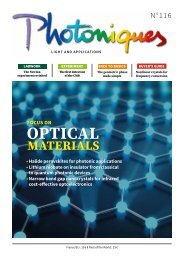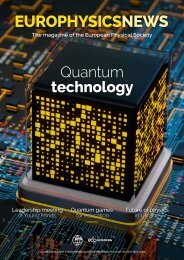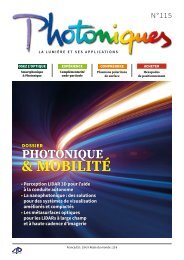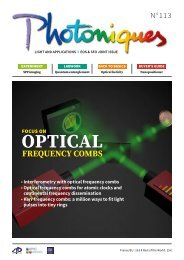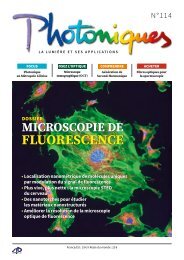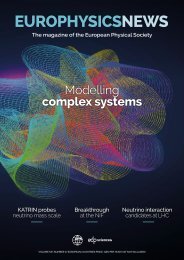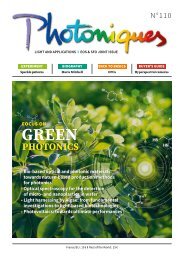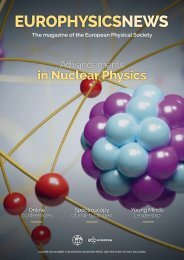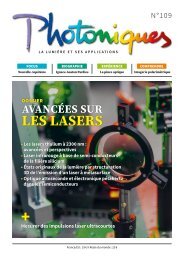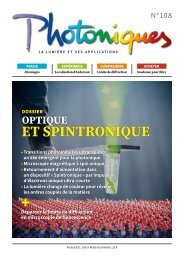EPN 53-3
You also want an ePaper? Increase the reach of your titles
YUMPU automatically turns print PDFs into web optimized ePapers that Google loves.
ACCELERATORS FOR HEALTH<br />
FEATURES<br />
to take place with electron, photon and more recently for<br />
proton beams. For details we refer to [2, 3].<br />
Towards a compact and flexible<br />
Hadron Therapy facility<br />
For proton therapy, compact accelerator systems are<br />
nowadays available on the market: mostly cyclotrons in<br />
Europe and America and synchrotrons in Japan. The irradiation<br />
is mainly done via 3D beam-scanning.<br />
Cyclotrons have the advantage that they are very compact<br />
and have only a few tuning parameters, thus are simple<br />
to operate in a hospital environment. However, scaling to<br />
the energies needed for Carbon-ions, which have a factor<br />
3 higher beam rigidity (i.e. the resistance to deflection by a<br />
magnetic field) is challenging. Another limitation of conventional<br />
cyclotrons is their fixed extraction energy, which<br />
implies the use of degraders, with associated transmission<br />
losses and radioprotection constrains. Current R&D goes<br />
in the direction of energy-variable cyclotrons and the use<br />
of high-field superconducting (SC) iron free magnets [3].<br />
Synchrotrons are easily scalable to ion operation, even<br />
if this implies an increase of their footprint, and allow acceleration<br />
of different type of ions. The preferred choice<br />
for carbon-ions today is a rather large synchrotron (of<br />
>20-m diameter compared to the 6-m size for protons).<br />
Most important, synchrotrons are flexible with respect<br />
to the extraction energy, which can be easily changed<br />
between one cycle to the next. A limitation of today synchrotrons,<br />
though, is the length of each cycle, of the order<br />
of 1s. In Europe, and following what was recently implemented<br />
in National Institute of Radiological Sciences<br />
(NIRS) in Japan [5], the tendency is to operate synchrotrons<br />
with the so-called multi-energy extraction (MEE)<br />
scheme, to deliver beams at different energies within the<br />
same cycle, thus saving time.<br />
Ultimately, if one could accelerate the total number<br />
of ions needed for a treatment session within one cycle<br />
(thus a factor 10-20 times higher intensity, accumulated<br />
by multi-turn injection), the full dose will be delivered<br />
significantly faster. Moreover, this mode of operation<br />
will make the use of SC magnets feasible, thus allowing<br />
a significant reduction of the dimensions of the ion<br />
synchrotron (indeed the SC magnets ramping time is<br />
much longer than for NC magnets). The R&D in this<br />
sense focus on ions sources to reliably deliver a higher<br />
current, on advanced injection and extraction schemes<br />
and on strongly curved SC magnets. The development of<br />
a SC-magnet carbon-ion synchrotron is precisely one of<br />
the main objectives of the Heavy Ion Therapy Research<br />
Integration (HITRIplus) [6] and what is being studied by<br />
the SEEIIST (South East Europe International Institute<br />
for Sustainable Technologies) [7] and the CERN NIMMS<br />
(Next Ion Medical Machine Study) initiative [8].<br />
Accelerators other than cyclotrons and synchrotrons<br />
are also under study, in particular Fixed Field Alternating<br />
gradient (FFA) and linacs. After several years of R&D and<br />
developments in research and international laboratories<br />
environment, the first linac based proton therapy facilities<br />
is under construction and commissioning in Europe.<br />
With the use of high-frequency high-gradient copper<br />
structures, designed to achieve relatively compact solution<br />
and high repetition rate operation, linacs will allow<br />
the production of beams with fast energy variation as<br />
well as small emittance beams that are potentially suited<br />
for the further development of mini-beams dose delivery<br />
techniques. Detailed information in [9, 10].<br />
b FIG. 1:<br />
Dose profile for<br />
various particle<br />
beams in water<br />
(beam widths<br />
r=0.5 cm)<br />
<strong>EPN</strong> <strong>53</strong>/3 17



